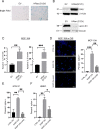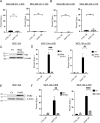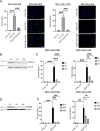This is a preprint.
A role for fibroblast-derived SASP factors in the activation of pyroptotic cell death in mammary epithelial cells
- PMID: 36865231
- PMCID: PMC9980130
- DOI: 10.1101/2023.02.21.529458
A role for fibroblast-derived SASP factors in the activation of pyroptotic cell death in mammary epithelial cells
Update in
-
A role for fibroblast-derived SASP factors in the activation of pyroptotic cell death in mammary epithelial cells.J Biol Chem. 2023 Jul;299(7):104922. doi: 10.1016/j.jbc.2023.104922. Epub 2023 Jun 14. J Biol Chem. 2023. PMID: 37321449 Free PMC article.
Abstract
In normal tissue homeostasis, bidirectional communication between different cell types can shape numerous biological outcomes. Many studies have documented instances of reciprocal communication between fibroblasts and cancer cells that functionally change cancer cell behavior. However, less is known about how these heterotypic interactions shape epithelial cell function in the absence of oncogenic transformation. Furthermore, fibroblasts are prone to undergo senescence, which is typified by an irreversible cell cycle arrest. Senescent fibroblasts are also known to secrete various cytokines into the extracellular space; a phenomenon that is termed the senescence-associated secretory phenotype (SASP). While the role of fibroblast derived SASP factors on cancer cells has been well studied, the impact of these factors on normal epithelial cells remains poorly understood. We discovered that treatment of normal mammary epithelial cells with conditioned media (CM) from senescent fibroblasts (SASP CM) results in a caspase-dependent cell death. This capacity of SASP CM to cause cell death is maintained across multiple senescence-inducing stimuli. However, the activation of oncogenic signaling in mammary epithelial cells mitigates the ability of SASP CM to induce cell death. Despite the reliance of this cell death on caspase activation, we discovered that SASP CM does not cause cell death by the extrinsic or intrinsic apoptotic pathway. Instead, these cells die by an NLRP3, caspase-1, and gasdermin D (GSDMD)-dependent induction of pyroptosis. Taken together, our findings reveal that senescent fibroblasts can cause pyroptosis in neighboring mammary epithelial cells, which has implications for therapeutic strategies that perturb the behavior of senescent cells.
Conflict of interest statement
Conflict of interest
The authors declare that they have no conflicts of interest with the contents of this article.
Figures





References
-
- Szekanecz Z., and Koch A. E. (2016) Successes and failures of chemokine-pathway targeting in rheumatoid arthritis. Nat Rev Rheumatol 12, 5–13 - PubMed
Publication types
Grants and funding
LinkOut - more resources
Full Text Sources
